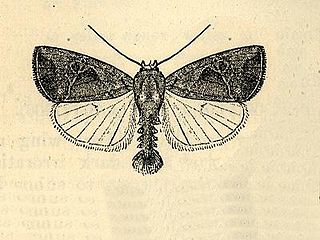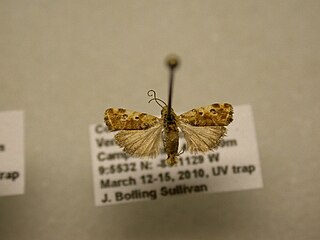
Elaphria nucicolora, the sugarcane midget, is a moth of the family Noctuidae. The species was first described by Achille Guenée in 1852. It is found from the south-eastern United States, through Guadeloupe, Jamaica and Puerto Rico to tropical South America. It is also present on the Hawaiian islands of Oahu, Maui and Hawaii.
Agrotis apicalis is a moth of the family Noctuidae first described by Gottlieb August Wilhelm Herrich-Schäffer in 1868. It is found in Florida, the Dominican Republic, Jamaica, Puerto Rico and Cuba.

Spragueia apicalis, the yellow spragueia, is a moth of the family Noctuidae. The species was first described by Gottlieb August Wilhelm Herrich-Schäffer in 1868. It is also found in North America, Central America, Cuba and Peru.

Elaphria agrotina is a moth of the family Noctuidae first described by Achille Guenée in 1852. It is found from North America, through Central America, the Antilles and Cuba to Brazil and Argentina.
Eutelia furcata, the Florida eutelia moth, is a moth of the family Noctuidae. The species was first described by Francis Walker in 1865. It is found from the southern United States to Mexico, Cuba, Puerto Rico and Central America.
Burtia rubella is a moth in the subfamily Arctiinae first described by Augustus Radcliffe Grote in 1866. It is found on Cuba.

Catabenoides vitrina is a moth of the family Noctuidae first described by Francis Walker in 1857. It is found from California to western Texas and south through Mexico to Central America. It is also found in the Caribbean, including Cuba.
Eunomia insularis is a moth in the subfamily Arctiinae first described by Augustus Radcliffe Grote in 1866. It is found on Cuba.

Callopistria floridensis, the Florida fern moth or Florida fern caterpillar, is a moth of the family Noctuidae. It is found from North America, south through the Caribbean, Mexico and Central America to Ecuador.

Spragueia perstructana is a moth of the family Noctuidae first described by Francis Walker in 1865. It is found from the United States, south to the Caribbean and Central America, including Costa Rica.
Leucania inconspicua is a moth of the family Noctuidae first described by Gottlieb August Wilhelm Herrich-Schäffer in 1868. It is found in Florida, Cuba, Puerto Rico, Jamaica, the Lesser Antilles and from Mexico to Brazil.

Orthodes majuscula, the rustic Quaker, is a moth of the family Noctuidae. The species was first described by Gottlieb August Wilhelm Herrich-Schäffer in 1868. It is widespread throughout the New World, including eastern North America, Cuba, Mexico, Costa Rica and Brazil.
Cobubatha metaspilaris is a moth of the family Noctuidae, described by Francis Walker in 1863. It is found in the southern United States, British Virgin Islands and Cuba.
Lacinipolia parvula is a moth of the family Noctuidae first described by Gottlieb August Wilhelm Herrich-Schäffer in 1868. It is found in Florida and on Cuba and Puerto Rico.
Horama pennipes is a moth in the subfamily Arctiinae first described by Augustus Radcliffe Grote in 1866. It is found on Cuba.
Horama diffissa is a moth in the family Erebidae first described by Augustus Radcliffe Grote in 1866. It is found in Cuba and Haiti.
Speocropia trichroma is a moth of the family Noctuidae first described by Gottlieb August Wilhelm Herrich-Schäffer in 1868. It is found in Florida and on Cuba.

Spodoptera pulchella, the Caribbean armyworm moth, is a moth of the family Noctuidae found in Florida and Texas, Central America, the Greater Antilles, and the Bahamas. It was first described by Gottlieb August Wilhelm Herrich-Schäffer in 1868.

Condica punctifera is a moth of the family Noctuidae first described by Francis Walker in 1857. It is found in southern Florida and on the Bahamas, Cuba, Jamaica, Hispaniola and Puerto Rico.

Euscirrhopterus gloveri, the purslane moth, is an owlet moth. The species was first described by Augustus Radcliffe Grote and Coleman Townsend Robinson in 1868. It is found in North America.









